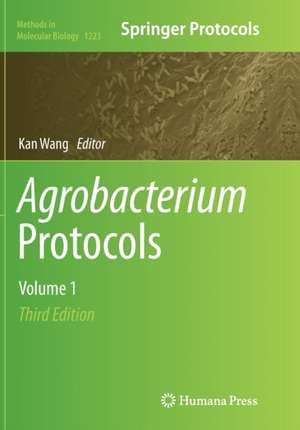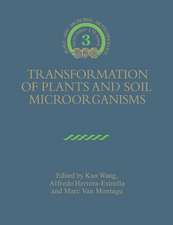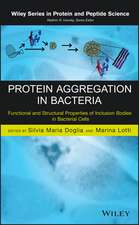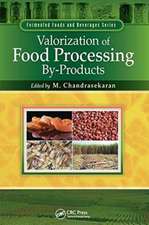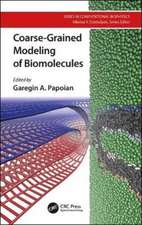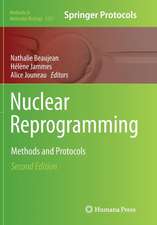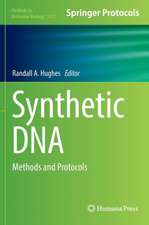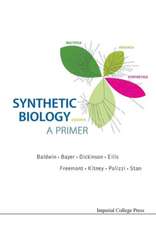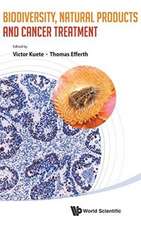Agrobacterium Protocols: Volume 1: Methods in Molecular Biology, cartea 1223
Editat de Kan Wangen Limba Engleză Paperback – 23 aug 2016
Volume 1 details updated techniques available for 18 plant species drawn from cereal crops, legume plants, vegetable plants, and three model plant species: Brachypodium distachyon, Medicago truncatula, and Setaria viridis. It also updates a chapter for vector construction, a step critical to a successful plant transformation process. Written in the highly successful Methods in Molecular Biology series format, chapters include introductions to their respective topics, lists of the necessary materials and reagents, step-by-step, readily reproducible laboratory protocols, and tips on troubleshooting and avoiding known pitfalls.
Authoritative and cutting-edge, Agrobacterium Protocols, Third Edition facilitates the transfer of this rapidly developing technology to all researchers for use in both fundamental and applied biology.
| Toate formatele și edițiile | Preț | Express |
|---|---|---|
| Paperback (4) | 705.83 lei 6-8 săpt. | |
| Springer – 23 aug 2016 | 705.83 lei 6-8 săpt. | |
| Springer – 23 aug 2016 | 785.06 lei 6-8 săpt. | |
| Humana Press Inc. – 9 dec 2010 | 953.52 lei 6-8 săpt. | |
| Humana Press Inc. – 9 dec 2010 | 1225.62 lei 6-8 săpt. | |
| Hardback (4) | 657.73 lei 6-8 săpt. | |
| Springer – 22 noi 2014 | 657.73 lei 6-8 săpt. | |
| Springer – 9 oct 2014 | 960.78 lei 6-8 săpt. | |
| Humana Press Inc. – sep 2006 | 963.15 lei 6-8 săpt. | |
| Humana Press Inc. – iun 2006 | 1235.25 lei 6-8 săpt. |
Din seria Methods in Molecular Biology
- 9%
 Preț: 791.59 lei
Preț: 791.59 lei - 23%
 Preț: 598.56 lei
Preț: 598.56 lei - 20%
 Preț: 882.95 lei
Preț: 882.95 lei -
 Preț: 252.04 lei
Preț: 252.04 lei - 5%
 Preț: 802.69 lei
Preț: 802.69 lei - 5%
 Preț: 729.61 lei
Preț: 729.61 lei - 5%
 Preț: 731.43 lei
Preț: 731.43 lei - 5%
 Preț: 741.30 lei
Preț: 741.30 lei - 5%
 Preț: 747.16 lei
Preț: 747.16 lei - 15%
 Preț: 663.45 lei
Preț: 663.45 lei - 18%
 Preț: 1025.34 lei
Preț: 1025.34 lei - 5%
 Preț: 734.57 lei
Preț: 734.57 lei - 18%
 Preț: 914.20 lei
Preț: 914.20 lei - 15%
 Preț: 664.61 lei
Preț: 664.61 lei - 15%
 Preț: 654.12 lei
Preț: 654.12 lei - 18%
 Preț: 1414.74 lei
Preț: 1414.74 lei - 5%
 Preț: 742.60 lei
Preț: 742.60 lei - 20%
 Preț: 821.63 lei
Preț: 821.63 lei - 18%
 Preț: 972.30 lei
Preț: 972.30 lei - 15%
 Preț: 660.49 lei
Preț: 660.49 lei - 5%
 Preț: 738.41 lei
Preț: 738.41 lei - 18%
 Preț: 984.92 lei
Preț: 984.92 lei - 5%
 Preț: 733.29 lei
Preț: 733.29 lei -
 Preț: 392.58 lei
Preț: 392.58 lei - 5%
 Preț: 746.26 lei
Preț: 746.26 lei - 18%
 Preț: 962.66 lei
Preț: 962.66 lei - 23%
 Preț: 860.21 lei
Preț: 860.21 lei - 15%
 Preț: 652.64 lei
Preț: 652.64 lei - 5%
 Preț: 1055.50 lei
Preț: 1055.50 lei - 23%
 Preț: 883.85 lei
Preț: 883.85 lei - 19%
 Preț: 491.88 lei
Preț: 491.88 lei - 5%
 Preț: 1038.84 lei
Preț: 1038.84 lei - 5%
 Preț: 524.15 lei
Preț: 524.15 lei - 18%
 Preț: 2122.34 lei
Preț: 2122.34 lei - 5%
 Preț: 1299.23 lei
Preț: 1299.23 lei - 5%
 Preț: 1339.10 lei
Preț: 1339.10 lei - 18%
 Preț: 1390.26 lei
Preț: 1390.26 lei - 18%
 Preț: 1395.63 lei
Preț: 1395.63 lei - 18%
 Preț: 1129.65 lei
Preț: 1129.65 lei - 18%
 Preț: 1408.26 lei
Preț: 1408.26 lei - 18%
 Preț: 1124.92 lei
Preț: 1124.92 lei - 18%
 Preț: 966.27 lei
Preț: 966.27 lei - 5%
 Preț: 1299.99 lei
Preț: 1299.99 lei - 5%
 Preț: 1108.51 lei
Preț: 1108.51 lei - 5%
 Preț: 983.72 lei
Preț: 983.72 lei - 5%
 Preț: 728.16 lei
Preț: 728.16 lei - 18%
 Preț: 1118.62 lei
Preț: 1118.62 lei - 18%
 Preț: 955.25 lei
Preț: 955.25 lei - 5%
 Preț: 1035.60 lei
Preț: 1035.60 lei - 18%
 Preț: 1400.35 lei
Preț: 1400.35 lei
Preț: 705.83 lei
Preț vechi: 830.39 lei
-15% Nou
Puncte Express: 1059
Preț estimativ în valută:
135.06€ • 141.37$ • 112.41£
135.06€ • 141.37$ • 112.41£
Carte tipărită la comandă
Livrare economică 31 martie-14 aprilie
Preluare comenzi: 021 569.72.76
Specificații
ISBN-13: 9781493945412
ISBN-10: 1493945416
Pagini: 382
Ilustrații: XIV, 368 p. 42 illus., 29 illus. in color.
Dimensiuni: 178 x 254 x 20 mm
Greutate: 0.67 kg
Ediția:Softcover reprint of the original 3rd ed. 2015
Editura: Springer
Colecția Springer
Seria Methods in Molecular Biology
Locul publicării:New York, NY, United States
ISBN-10: 1493945416
Pagini: 382
Ilustrații: XIV, 368 p. 42 illus., 29 illus. in color.
Dimensiuni: 178 x 254 x 20 mm
Greutate: 0.67 kg
Ediția:Softcover reprint of the original 3rd ed. 2015
Editura: Springer
Colecția Springer
Seria Methods in Molecular Biology
Locul publicării:New York, NY, United States
Cuprins
Gateway® Compatible Plant Transformation Vectors.- Brachypodium Distachyon.- Medicago Truncatula Transformation Using Cotyledonary Explants.- Medicago Truncatula Transformation Using Leaf Explants.- Setaria Viridis.- Barley (Hordeum Vulgare L.) Transformation Using Immature Embryos.- Barley (Hordeum Vulgare L.) Transformation Using Embryogenic Pollen Cultures.- Maize (Zea Mays L.).- Maize, Tropical (Zea Mays L.). - Finger Millet [Eleusine Coracana (L.) Gaertn].- Oat (Avena Sativa L.).- Rice, Indica (Oryza Sativa L.).- Rice, Japonica (Oryza Sativa L.).- Sorghum (Sorghum Bicolor L.).- Wheat (Triticum Aestivum L.) Transformation Using Immature Embryos.- Wheat (Triticum Aestivum L.) Transformation Using Mature Embryos.- Alfalfa (Medicago Sativa L.).- Clovers (Trifolium Spp.).- Clover, Red (Trifolium Pratense).- Cowpea [Vigna Unguiculata (L.) Walp].- Lentil (Lens Culinaris Medik.).- Soybean [Glycine Max (L.) Merr.].- Brassica Oleracea And B. Napus.- Cucumber (Cucumis Sativus L.) and Kabocha Squash (Cucurbita Moschata Duch).- Pepper, Chili (Capsicum Annuum).- Pepper, Chili (Capsicum Annuum).- Pepper, Sweet (Capsicum Annuum).- Sugar Beet (Beta Vulgaris L.).- Tomato (Solanum Lycopersicum).
Textul de pe ultima copertă
Rapid changes and significant progress have been made in the Agrobacterium field, such as genetically transforming plants for both basic research purposes and agricultural development. In Agrobacterium Protocols, Third Edition, Volumes 1 and 2, a team of leading experts and veteran researchers describe in detail techniques for delivering DNA to plant cells and permanently altering their genomes. This edition emphasizes agricultural crops and plant species with economic values, with updated protocols on 32 plant species and protocols involving 19 new species. Together with the 1st and 2nd editions, these two volumes offer Agrobacterium-mediated genetic transformation protocols for a total of 76 plant species. For a number of important plants such as rice, barley, wheat and citrus, multiple protocols using different starting plant materials for transformation are included.
Volume 1 details updated techniques available for 18 plant species drawn from cereal crops, legume plants, vegetable plants, and three model plant species: Brachypodium distachyon, Medicago truncatula, and Setaria viridis. It also updates a chapter for vector construction, a step critical to a successful plant transformation process. Written in the highly successful Methods in Molecular Biology series format, chapters include introductions to their respective topics, lists of the necessary materials and reagents, step-by-step, readily reproducible laboratory protocols, and tips on troubleshooting and avoiding known pitfalls.
Authoritative and cutting-edge, Agrobacterium Protocols, Third Edition facilitates the transfer of this rapidly developing technology to all researchers for use in both fundamental and applied biology.
Volume 1 details updated techniques available for 18 plant species drawn from cereal crops, legume plants, vegetable plants, and three model plant species: Brachypodium distachyon, Medicago truncatula, and Setaria viridis. It also updates a chapter for vector construction, a step critical to a successful plant transformation process. Written in the highly successful Methods in Molecular Biology series format, chapters include introductions to their respective topics, lists of the necessary materials and reagents, step-by-step, readily reproducible laboratory protocols, and tips on troubleshooting and avoiding known pitfalls.
Authoritative and cutting-edge, Agrobacterium Protocols, Third Edition facilitates the transfer of this rapidly developing technology to all researchers for use in both fundamental and applied biology.
Caracteristici
Emphasizes agricultural crops or plant species with economic values Provides step-by-step detail essential for reproducible results Contains key notes and implementation advice from the experts Includes supplementary material: sn.pub/extras
Recenzii
From the reviews of the second edition:
"This book is intended as a laboratory manual for researchers using Agrobacterium tumefaciens for plant transformation. It covers the basics of culturing and transforming Agrobacterium … . You don’t expect a lab manual to be ideal … reading, but I found this to be surprisingly readable. … The book would be especially useful for someone just starting plant transformation work or changing to new plant species and … it would also be useful reading for Masters students." (Heather Macdonald, Microbiology Today, November, 2006)
"Methods in Molecular Biology opens … a field concerning Agrobacterium-mediated transformation of plants. … Each chapter is written by the leader in the field … and offers a detailed manual of the transformation protocol. … All users of this book will certainly appreciate the notes sections that bring additional information on potential difficulties in the protocols and alternative materials or methods. The book is the fountainhead of recent practical knowledge concerning Agrobacterium-mediated transformation and … it will become the core manual … ." (J. BRlZA, Biologia Plantarum, Vol. 51 (2), 2007)
"The book’s chapters are organized in a highly detailed fashion, providing readers not only with step-by-step protocols … but also with a comprehensive list of equipment and materials. … With such a rich source of information, organized to be easy to read and very simple to implement, the book should be considered a must for every plant biology laboratory. … It will also be an excellent tool for training students, doctorates, technicians, and other laboratory personnel in the art of plant genetic transformation." (Tzvi Tzfira, Quarterly Review of Biology, Vol. 82, March, 2007)
"This book is intended as a laboratory manual for researchers using Agrobacterium tumefaciens for plant transformation. It covers the basics of culturing and transforming Agrobacterium … . You don’t expect a lab manual to be ideal … reading, but I found this to be surprisingly readable. … The book would be especially useful for someone just starting plant transformation work or changing to new plant species and … it would also be useful reading for Masters students." (Heather Macdonald, Microbiology Today, November, 2006)
"Methods in Molecular Biology opens … a field concerning Agrobacterium-mediated transformation of plants. … Each chapter is written by the leader in the field … and offers a detailed manual of the transformation protocol. … All users of this book will certainly appreciate the notes sections that bring additional information on potential difficulties in the protocols and alternative materials or methods. The book is the fountainhead of recent practical knowledge concerning Agrobacterium-mediated transformation and … it will become the core manual … ." (J. BRlZA, Biologia Plantarum, Vol. 51 (2), 2007)
"The book’s chapters are organized in a highly detailed fashion, providing readers not only with step-by-step protocols … but also with a comprehensive list of equipment and materials. … With such a rich source of information, organized to be easy to read and very simple to implement, the book should be considered a must for every plant biology laboratory. … It will also be an excellent tool for training students, doctorates, technicians, and other laboratory personnel in the art of plant genetic transformation." (Tzvi Tzfira, Quarterly Review of Biology, Vol. 82, March, 2007)
